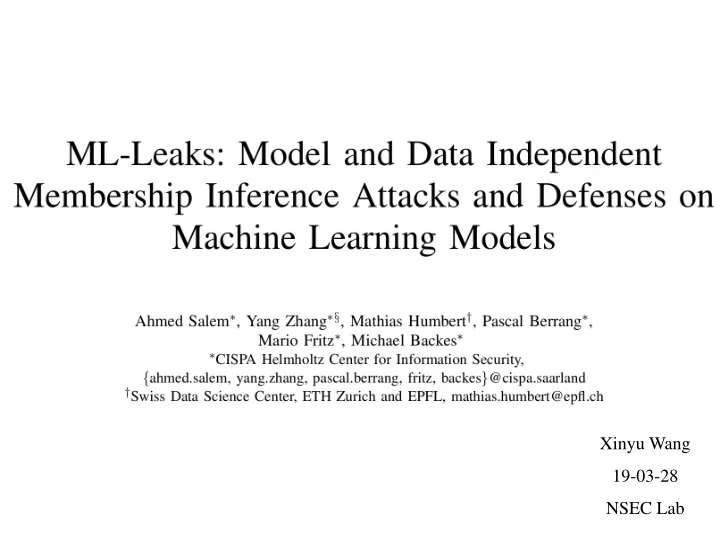

Xinyu Wang 19-03-28 NSEC Lab
OUTLINE • Background About Membership Inference Attack • Commentary on Previous Work • Proposed Attacks • Proposed Defenses • Conclusion
BACKGROUND Training data can be sensitive: • Financial data • Location and activity data • Biomedical data • Etc.
BACKGROUND • Shokri et al. ,Oakland 2017 • Membership Inference : Given a machine learning model (target model) and a record ( x ), determine whether this record was used as part (member) of the model's training dataset or not.
BACKGROUND Shokri et al. proposed a three-step approach: 1. Shadow model training Assume the attacker can get a shadow training set S , which shares the same distribution with T train .
BACKGROUND 2. Attack model training Get the attack training set A train from shadow training set ( S member and S non-member ) and shadow models.
BACKGROUND 3. Membership inference In the “attack model training” step we have modeled the relationship between prediction and membership Therefore, with the prediction of data record x , we can predict the membership of x .
BACKGROUND Three strong assumptions • Multiple shadow models : The attacker has to train multiple shadow models • to obtain a large training dataset for the attack model • Model dependent : The attacker knows the structure of the target model • training algorithm, and • hyperparameters • Data dependent : The attacker can get a shadow training dataset S • S shares the same distribution with T train (training dataset of the target model)
COMMENTARY Three strong assumptions • Multiple shadow models • Model dependent • Data dependent These strong assumptions limit the scenario of the membership inference attack. Therefore, this paper tries to relax these assumptions step-by-step.
PROPOSED ATTACKS Strong assumptions: 1. Multiple shadow models 2. Model dependent 3. Data dependent Relax strong assumptions step-by-step: 1. Relax assumption 1: using only one shadow model 2. Relax assumption 2: independence of model structure 3. Relax assumption 3: independence of data distribution
PROPOSED ATTACKS Step 1: using only one shadow model Shokri: One shadow model:
PROPOSED ATTACKS Step 1: using only one shadow model Results: Performance is similar to Shokri attack.
PROPOSED ATTACKS Step 2: independence of model structure Experiments show: • Changing hyperparameters have no significant effect on the performance • Simply changing training algorithm of the shadow model leads to bad performance • Therefore this paper proposes a technique called combining attack
PROPOSED ATTACKS Step 2: independence of model structure One shadow model: Combining attack: train sub-shadow models using a variety of different training algorithms and combine them
PROPOSED ATTACKS Step 2: independence of model structure Results: similar performance or even better
PROPOSED ATTACKS Step 3: independence of data distribution Data transferring attack : use dataset from a different distribution to train the shadow model Target model: Shadow model:
PROPOSED ATTACKS Step 3: independence of data distribution Intuition: different datasets share similar relations between prediction and membership
PROPOSED ATTACKS Step 3: independence of data distribution Data transferring attack : use dataset from a different distribution to train the shadow model Target model: Shadow model:
PROPOSED ATTACKS Step 3: independence of data distribution Results: For instance, • Use CIFAR-100 to attack Face: precision remains 0.95 • Use CIFAR-100 to attack News: precision improves from 0.88 to 0.89
PROPOSED DEFENSES Principle: reduce overfitting • Dropout • Model Stacking
PROPOSED DEFENSES Consider the effect on the target model’s accuracy • Dropout • Model Stacking
Recommend
More recommend